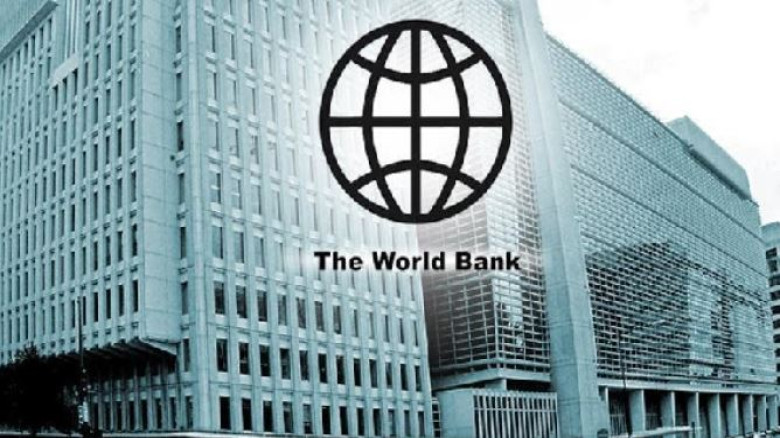2023: World Bank says Ghana’s inflation to rise by 3 percentage points
The World Bank’s April 2023 edition of the Africa’s Pulse report has said the rate of inflation in Ghana and two other countries in the region, “is expected to accelerate by more than 3 percentage points in 2023 from last year”.
The other countries are Uganda, and Burundi.
Also, the Bretton Wood institution said the growth of non-resource-rich countries has been “more than proportionally affected by the poly-crisis, as the deterioration of their terms of trade increased their import bills”.
The report shows growth across Sub-Saharan Africa remaining sluggish, dragged down by uncertainty in the global economy, the underperformance of the continent’s largest economies, high inflation, and a sharp deceleration of investment growth – and is insufficient to reduce extreme poverty.
The real GDP of non-resource-rich countries is expected to have dropped by 0.6 percentage point, to 4.2 percent in 2022.
For this group of countries, inflation in 2022 nearly doubled to 8.3 per cent (from 4.3 per cent in 2021); the current account deficit widened to 6.1 per cent of GDP, and the fiscal deficit deteriorated slightly to 5.6 per cent of GDP.
These developments heightened pressures that weakened domestic currencies and led policymakers to tighten their monetary policy stance— thus weighing on economic activity, the report noted.
For instance, the average growth forecast among West African Economic and Monetary Union (WAEMU) countries is expected to be 5.6 percent for 2022, down from 6.0 percent in 2021—but 0.7 percentage point higher than the October 2022 Africa’s Pulse forecast.
GDP growth decelerated by more than 1 percentage point from 2021 in Benin (which grew by 6 per cent in 2022), Burkina Faso (2.5 per cent), Mali (1.8 per cent), and Senegal (4.2 per cent), while a mild slowdown—less than 0.5 percentage point—is observed in Côte d’Ivoire (6.7 per cent) and Togo (4.9 percent). The sub-region is characterized by fiscal and current account deficits (twin deficits) attributed to government interventions to contain inflation that has breached the regional target of 3 per cent.
Outside the WAEMU, growth in Ghana is expected to have slowed in 2022 to 3.2 per cent, down from 5.4 per cent in 2021 and far below the country’s average pre-pandemic performance (6.1 per cent).
The economy has been struggling with high levels of public debt and elevated inflation (52.8 per cent in February 2023) fueled by a sharp weakening of the cedi (a cumulative depreciation of 40 per cent in 2022 and about 20 per cent in 2023 so far).
To curb rising inflation, the Bank of Ghana raised its policy rate by a record 1,500 basis points to 29.5 per cent in March 2023, from 14.5 per cent in December 2021.
In other countries in the region, the report said real GDP growth in Ethiopia amounted to 6.4 per cent in 2022, slightly higher than the 6.3 per cent growth registered during the preceding year.
The service sector was the most significant contributor to growth, followed by agriculture. While real growth was on the upside, it is still significantly below the pre-COVID-19 growth rate of 9.0 per cent registered in 2019.
Similarly, economic activity accelerated in Mauritius and Mozambique, by 8.3 and 4.1 percentage points, respectively, in 2022.
Growth in Mozambique stemmed from the increase in coal and aluminum output, thanks to high global demand, high prices, and the start of liquefied natural gas exports to Europe.
Mauritius benefited from the recovery in tourism assisted by the country’s high rate of COVID-19 vaccination
In Ghana, the World Bank said more timely data highlight the weakness of economic activity amid the deleterious global shocks and heightened macroeconomic instability.
GDP growth slowed to 0.7 per cent q/q in the third quarter of 2022, the weakest outcome since the height of the pandemic.
Rising inflation and high interest rates held back private consumption and investment, while government consumption has declined on the back of high debt service and restricted access to international capital markets.
Business and consumer confidence slumped in late 2022; however, the PMI is gradually picking up and signaling an expansion in economic activity (50.2 in February 2023).
On the external front, export growth has held up, while import growth has dwindled. Debt overhang also weighs on economic activity.
Government officials are seeking to restructure the country’s external debt through the Common Framework.
The report said the cedi has weakened and the sovereign spreads have remained high since the default. In Côte d’Ivoire, the latest data suggest that the economy slowed in the fourth quarter of 2022.
Industrial production contracted by 1.7 percent y/y in November due to weakness in both the mining and manufacturing sectors.
The trade balance swung into a deficit by end-2022 as import growth remained strong while export growth fell back.
Finally, inflation softened further, from 5.7 per cent y/y in November to 4.8 per cent y/y in January, on the back of easing food price pressures.
The report noted that inflation in Sub-Saharan Africa accelerated in 2022 to 9.2 per cent, from 4.5 per cent in 2021.
The slowdown in global demand, declining commodity prices, and the effects of the monetary policy tightening across the continent are expected to reduce inflation to 7.9 per cent in 2023, and further to 5 per cent in 2024 and 2025.
Headline inflation is still above the ceiling of the central bank target bands for all countries with an explicit nominal anchor.
Consumer prices rose at a faster pace in 2022 amid supply chain disruptions, pent-up demand associated with pandemic restrictions being lifted, and the war in Ukraine.
The number of countries with a two-digit average annual rate of inflation for the year increased from 9 in 2021 to 21 in 2022—that is, about 45 per cent of the countries in the region recorded two-digit inflation rates last year. This number is expected to decline to 12 countries in 2023 and drop even further to 6 in 2025.
Rising food and fuel prices as well as the depreciation of the exchange rate were the main drivers of inflationary pressures in the region—and, particularly, in countries like Ghana, Sudan, and Malawi.
The Ghanaian cedi, the worst-performing currency in the region during 2022, posted a depreciation of about 40 per cent.
It has weakened an additional 20 percent so far in 2023. Other currencies with significant losses last year include those of Sudan (23.6 per cent), Malawi (20.7 per cent), The Gambia (14.6 per cent), and Nigeria (10.2 percent).
Furthermore, rising food and energy prices continued to fuel headline inflation.
An inspection of monthly information available for 39 Sub-Saharan African countries by January 2023 shows that year-over-year food inflation remains high.
About 75 per cent of the countries in the region registered double-digit year-over-year inflation rates at the end of 2022, with the fastest increases experienced in Zimbabwe, Sudan, Ghana, Rwanda, Sierra Leone, Burundi, Malawi, and Ethiopia.
Domestic food inflation in Africa has remained sticky in some African countries while it has decelerated in others—although at a much slower pace than the disinflation of food prices in global markets.
This might be attributed to currency depreciation—as countries in the region import most of their food staples— as well as high input costs (high oil and natural gas prices affecting transportation and refrigeration, and nitrogenous fertilisers) and extreme weather events (for instance, droughts in the Horn of Africa).
Bringing down inflation and anchoring inflation expectations should continue to be a priority for policymakers, to prevent further deterioration of people’s incomes and food security and avert social unrest and conflict.
The rate of inflation is expected to have peaked for most countries in the region.
Average annual inflation forecasts project that about 70 per cent of the countries in the region are expected to have a lower inflation rate in 2023 compared with that in 2022.
The median inflation for the group of countries where inflation is expected to have peaked last year drops to 7 per cent in 2023 (from nearly 10 per cent in 2022).
However, despite the declining inflation rates across many countries in the region, the rates of consumer price growth are still high, above target, and above pre-pandemic levels.
Cross-country differences in the evolution of external and fiscal balances as well as debt dynamics are also present in countries’ inflation rates.
Inflation is expected to remain contained in resource-rich countries—and, particularly, oil-rich countries where the impact of food and fuel inflation as well as the currency has been limited through a series of monetary and fiscal measures.
The median rate of inflation in oil exporting countries in the region is expected to decline to 5.2 percent in 2023 and edge down to 4 and 3 per cent in 2024 and 2025, respectively.
In non-resource-rich countries, inflation was elevated in 2022 (8.3 per cent) and is set to decline slowly to 6.5 per cent in 2023, and stabilise at 5 per cent in 2025.











Leave A Comment